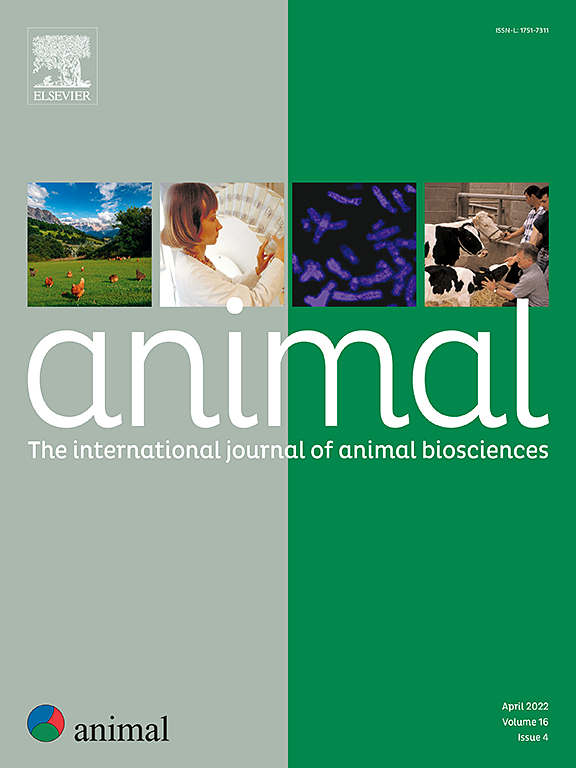Simulation of long-term impact of dairy cattle mating programmes using genomic information at the herd level
IF 4
2区 农林科学
Q1 AGRICULTURE, DAIRY & ANIMAL SCIENCE
引用次数: 0
Abstract
Genotyping provides breeders with new information at the single nucleotide polymorphism level that can be used in mating programmes. This study used stochastic simulation to explore the long-term effects of genomic mating allocations combining economic scores and linear programming at the level of commercial herds. The economic scores included genetic level, a favourable monogenic trait (polledness), a recessive genetic defect, and parent relationships. The results showed that compared with only maximising genetic level, including genomic or pedigree relationship in the economic score lowered the rate of pedigree and genomic inbreeding with minimal effect on genetic gain. Including the cost of a recessive genetic defect in the score almost eliminated the risk of expression. We set the start allele frequency of polledness to ∼12%, and the value of polledness varied in the different scenarios (€0, €10, €50, and €100). Including an economic value for polledness of (≥ €50) in the economic score increased the frequency of polled animals by up to 0.037 per generation, without negatively impacting other comparison criteria. The use of genomic relationships was favourable for the rate of genomic inbreeding and performed as well as pedigree relationships concerning the rate of pedigree inbreeding. Limiting the number of females per bull and herd to a maximum of 5% instead of 10% also decreased the rate of inbreeding. The 5% females per bull and herd constraint lowered the variation in carrier frequency for genetic defects, which reduced the risk of mating two carriers of an unknown genetic defect in future generations after the widespread use of carriers in previous generations. However, the 10% females per bull constraint accelerated the increase in the polled allele. Therefore, planning matings with genomic information at the herd level involves important risk management decisions, such as balancing the trade-off between using fewer bulls to increase the polled allele frequency more quickly and using more bulls to reduce the rate of inbreeding and the variation in carrier frequency for genetic defects.
利用牛群水平的基因组信息模拟奶牛交配计划的长期影响
基因分型为育种者提供了可用于交配计划的单核苷酸多态性水平的新信息。本研究采用随机模拟的方法,在商品牛群的层面上探讨了结合经济评分和线性规划的基因组交配分配的长期效果。经济评分包括遗传水平、有利的单基因性状(花粉度)、隐性遗传缺陷和父母关系。结果表明,与仅最大化遗传水平相比,将基因组或血统关系纳入经济评分可降低血统和基因组近亲繁殖率,但对遗传增益的影响极小。将隐性遗传缺陷的代价纳入评分几乎消除了表达风险。我们将花粉症的起始等位基因频率设定为 12%,花粉症的价值在不同方案中有所不同(0 欧元、10 欧元、50 欧元和 100 欧元)。在经济评分中加入(≥ 50 欧元)的花粉症经济价值,可使每代花粉症动物的频率增加多达 0.037,而不会对其他比较标准产生负面影响。基因组关系的使用对基因组近交率有利,在血统近交率方面的表现与血统关系一样好。将每头公牛和每个牛群的雌性数量限制在最多 5%,而不是 10%,也降低了近交率。每头公牛和每群 5%的雌性限制降低了遗传缺陷携带者频率的变化,从而降低了在前几代广泛使用携带者后,后代出现两个未知遗传缺陷携带者交配的风险。然而,每头公牛 10%的雌性限制加速了花粉等位基因的增加。因此,在牛群层面利用基因组信息进行配种规划涉及到重要的风险管理决策,如在使用较少公牛以更快地增加花粉等位基因频率与使用较多公牛以降低近亲繁殖率和遗传缺陷携带者频率变化之间权衡利弊。
本文章由计算机程序翻译,如有差异,请以英文原文为准。
求助全文
约1分钟内获得全文
求助全文
来源期刊

Animal
农林科学-奶制品与动物科学
CiteScore
7.50
自引率
2.80%
发文量
246
审稿时长
3 months
期刊介绍:
Editorial board
animal attracts the best research in animal biology and animal systems from across the spectrum of the agricultural, biomedical, and environmental sciences. It is the central element in an exciting collaboration between the British Society of Animal Science (BSAS), Institut National de la Recherche Agronomique (INRA) and the European Federation of Animal Science (EAAP) and represents a merging of three scientific journals: Animal Science; Animal Research; Reproduction, Nutrition, Development. animal publishes original cutting-edge research, ''hot'' topics and horizon-scanning reviews on animal-related aspects of the life sciences at the molecular, cellular, organ, whole animal and production system levels. The main subject areas include: breeding and genetics; nutrition; physiology and functional biology of systems; behaviour, health and welfare; farming systems, environmental impact and climate change; product quality, human health and well-being. Animal models and papers dealing with the integration of research between these topics and their impact on the environment and people are particularly welcome.
 求助内容:
求助内容: 应助结果提醒方式:
应助结果提醒方式:


